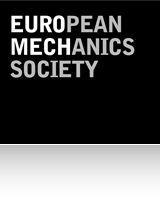505 – Multiscale effects in fatigue metals
Date:
5 July 2010 – 9 July 2010
Location:
Ecole Polytechnique, Palaiseau, France
Website:
Chairperson:
Dr. Andrei Constantinescu
CNRS Ecole Polytechnique
Laboratoire de Mécanique des Solides
91128 Palaiseau cedex
France
phone:+33 1 69 33 57 56
fax: +33 1 69 33 57 06
email: andrei.constantinescu@lms.polytechnique.fr
Co-chairperson
Dr. Pedro Donatella Portella
German Federal Institute for Material Research and Testing
Berlin
Germany
The pioneering mechanical models dedicated to the metals fatigue under cyclic loadings were macroscopic. Today, it is well accepted that the mechanisms underlying crack initiation start at the scale of dislocations. In the last two decades, researches have attempted to extend the experimental basis in this sense and to introduce this view in the modelling.
The experimental objective was to obtain information at the relevant scales (dislocations structures, slip bands, grains) by using complementary leading edge techniques: Transmission Electron Microscopy, Scanning Electron Microscopy with Electron Back-Scattered Diffraction, Atomic Force Microscopy, etc.
The theoretical and computational objectives were to compare and integrate observations in multiscale physically based models, as polycrystalline aggregates calculation or Discrete Dislocation Dynamics simulations. From the engineering point of view, there were some attempts to include these works in state-of-the-art fatigue predictions on structures but further effort should be provided in order to use these models on a day to day basis.
As a consequence, most of the recent developments are realized at the border between the communities of metallurgy, theoretical mechanics and mechanical engineering.
The purpose of the colloquium is to organise a meeting where these communities of matirials, theoretical mechanics and mechanical engineering can exchange state-of-the-art modelling and results on the multiscale mechanisms and mechanics in fatigue of metals. We expect that this cooperation should lead to openings of new complementary research fields, intimately coupling theoretical and numerical tools with new experimental resources.
The topics discussed during the colloquim are:
The experimental objective was to obtain information at the relevant scales (dislocations structures, slip bands, grains) by using complementary leading edge techniques: Transmission Electron Microscopy, Scanning Electron Microscopy with Electron Back-Scattered Diffraction, Atomic Force Microscopy, etc.
The theoretical and computational objectives were to compare and integrate observations in multiscale physically based models, as polycrystalline aggregates calculation or Discrete Dislocation Dynamics simulations. From the engineering point of view, there were some attempts to include these works in state-of-the-art fatigue predictions on structures but further effort should be provided in order to use these models on a day to day basis.
As a consequence, most of the recent developments are realized at the border between the communities of metallurgy, theoretical mechanics and mechanical engineering.
The purpose of the colloquium is to organise a meeting where these communities of matirials, theoretical mechanics and mechanical engineering can exchange state-of-the-art modelling and results on the multiscale mechanisms and mechanics in fatigue of metals. We expect that this cooperation should lead to openings of new complementary research fields, intimately coupling theoretical and numerical tools with new experimental resources.
The topics discussed during the colloquim are:
- experimental complementarities between TEM, SEM with EBSD, AFM and new opportunities offered by kinematic and/or thermal full-field measurements and acoustic emission at micrometric scales which enable the study of the forerunner signs of fatigue damage.
- numerical tools including Polycrystalline grain modelling and Discrete Dislocation Dynamic which are of great interests in crystalline plasticity for the definition of multiscale fatigue criteria.
- multiscale fatigue criteria and structural computations
